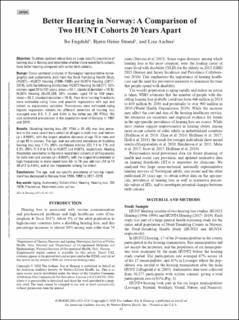| dc.description.abstract | Objective: To obtain updated robust data on a age-specific prevalence of hearing loss in Norway and determine whether more recent birth cohorts have better hearing compared with earlier birth cohorts. Design: Cross-sectional analyzes of Norwegian representative demographic and audiometric data from the Nord-Trøndelag Health Study (HUNT)—HUNT2 Hearing (1996–1998) and HUNT4 Hearing (2017–2019), with the following distribution: HUNT2 Hearing (N=50,277, 53% women, aged 20 to 101 years, mean = 50.1, standard deviation = 16.9); HUNT4 Hearing (N=28,339, 56% women, aged 19 to 100 years, mean = 53.2, standard deviation = 16.9). Pure-tone hearing thresholds were estimated using linear and quantile regressions with age and cohort as explanatory variables. Prevalences were estimated using logistic regression models for different severities of hearing loss averaged over 0.5, 1, 2, and 4 kHz in the better ear (BE PTA4). We also estimated prevalences at the population-level of Norway in 1997 and 2018. Results: Disabling hearing loss (BE PTA4 ≥ 35 dB) was less prevalent in the more recent born cohort at all ages in both men and women (p < 0.0001), with the largest absolute decrease at age 75 in men and at age 85 in women. The age- and sex-adjusted prevalence of disabling hearing loss was 7.7% (95% confidence interval [CI] 7.5 to 7.9) and 5.3% (95% CI 5.0 to 5.5) in HUNT2 and HUNT4, respectively. Hearing thresholds were better in the more recent born cohorts at all frequencies for both men and women (p < 0.0001), with the largest improvement at high frequencies in more recent born 60- to 70-year old men (10 to 11 dB at 3 to 4 kHz), and at low frequencies among the oldest. Conclusions: The age- and sex-specific prevalence of hearing impairment has decreased in Norway from 1996–1998 to 2017–2019. | |
